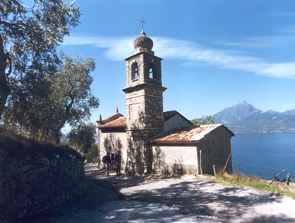TORRI DEL BENACO HOTELS - Garda Lake Torri del Benaco, Garda Lake Hotel, Garda Lake B&B, Garda Lake residences
|
WEBSITE UNDER RECONSTRUCTION, SORRY FOR ANY INCONVENIENCE.
|
| |
What to see in Torri del Benaco |
|
 |
|

|
|
 |
|
The centre of Torri's commercial activity is, and always has been, the harbour. Here are found the town's most important buildings, most importantly the castle built at the end of the 14th century by Antonio della Scala in order to protect his lands
from the expansionistic |
 |
|
aims of the Visconti of Milan. It now
houses an interesting ethnographic museum, and includes Italy's first
exhibition space dedicated to fresh water fishing,
as well as one of the last greenhouses for citrus
fruit built on Lake Garda, dating from the mid 18th
century. On the north side of the harbour - one of the most beautiful of the entire lake, its shell-shaped form dating back to Roman times - is the 15th century Gardesana palace, now a hotel with the same name. Here the Council of the Gardesana dall'Acqua met, a federation of ten Veronese lakeside communities to which the Venetian government granted a notable amount of independence. Incorporated into the palace is the recently restored church of the Holy Trinity, with frescoes of the 15th and 16th c. Veronese school. The port zone was occupied by Torri's merchants, whose ancient dwellings are still there. One in particular stands out for the elegance of its
facade interlaced with loggias. This was the home of
the interlaced with loggias. This was the home of
the Vacaris, functionaries representing the central
power of the Venetian republic. |
|
|
|
On the principal street of the town, several buildings displaying their noble origins may be singled out. On the corner of via Cairoli is Casa Mari, once the home of the wealthy Marai family, whose coat of arms still graces the entrance. The nearby Casa Viola is also of interest; it preserves almost unaltered - inside as well as outside - the character of a middle-class dwelling of the early 19th century.
At the extreme north of the town centre stands a worthy rival to the castle - the grandiose parish church built near the beginning of the 18th century. It contains magnificent baroque altars and altarpieces of high quality that attest to the prosperity of s an imposing edifice which, together with the city walls, was built by the king of Italy Berengarius I, in the first years of the 10th century. The walls are still standing, although now hidden amongst the town's buildings.
Near the Gardesana road rises the 14th century clock tower, once known as "del Comun" because during the middle ages it housed the "Vicina", an assembly of the heads of families who met there to discuss community affairs.
The surrounding countryside is no less rich in historical associations, with its small Romanesque churches and its naive wayside shrines that testify to the strong religious sentiments of the inhabitants.
On the way to the Coi district, we come to an oratory dedicated to St. Anthony of Padua which contains a striking 17th century fresco depicting the town of Torri enclosed in its walls, as it must have appeared at that time, viewed from this very spot.
To the south of the town we find the church of San Faustino, which contains precious 15th century frescoes and an urn containing the remains of the Blessed Pietro Malerba, one of the many hermits who in former times chose the upper lake as their refuge.
On the left side of the Val Vasana, which separates the parish of Torri from that of Pai, is situated the 18th century church of San Siro, erected by an inhabitant of the nearby district of Crér in
fulfillment of a vow. |
|
|
|
|
Privacy Policy
